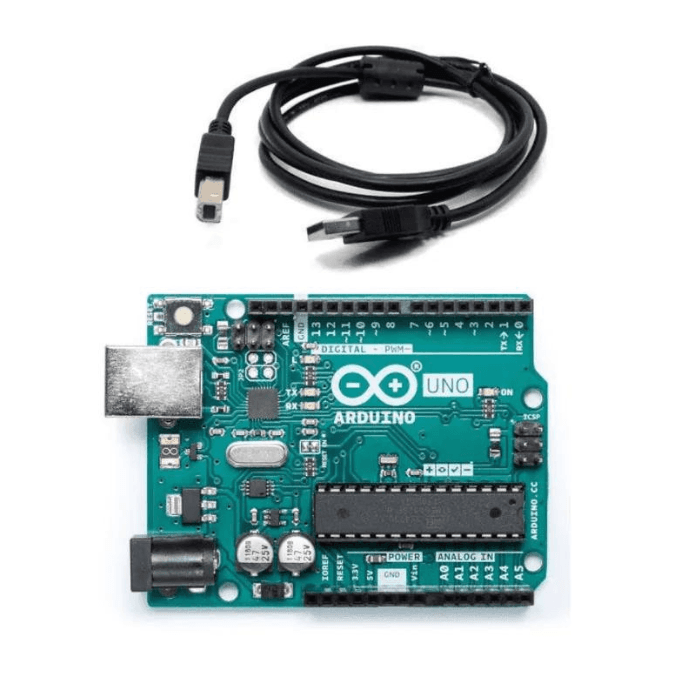In this guide, we will take a overview of difference between Arduino and Raspberry Pi boards and help you to solve your confusion in selection between Arduino and Raspberry Pi boards. Other than this guide will also make you understand how the comparison is done between arduino and raspberry pi and will help you in future to make comparison between arduino and raspberry pi by yourself. So set aside some time to read and lets dive into it!
Difference Between Arduino and Raspberry Pi
| Arduino | Raspberry Pi |
| Most important parameter which distinguishes both the boards is the processing unit. Arduino uses an 8-bit Atmega328P “Microcontroller.” So it is a MCU-based development board. |
Raspberry Pi is a credit card size computer that uses 4th gen Broadcom Advanced/Acorn Reduced Instruction Set (ARMv8) BCM2711 Cortex-A72, 64-bit quad-core with 4 threads SoC “Microprocessor” as a processing unit. |
| No operating system is required. | The operating system is required for booting. |
| Can run just one task at a time. | Can do multiple tasks simultaneously |
| Since Arduino is a microcontroller peripheral like processor, RAM, ROM are inside MCU itself. Here RAM is fixed( 2KB SRAM) and flash(32KB) | Since Raspberry Pi uses a microprocessor we externally connect RAM,memory for storage(128GB or more),etc. This is the reason why Raspberry Pi 4B comes in different RAM variants 1GB,2GB,4GB, and 8GB. |
| Clock frequency:16Mhz | Clock frequency:1.5Ghz |
| 20 GPIO pins( 5V voltage level): 14 digital and 6 analog | 40 GPIO pins (3.3V voltage level make sure you always check external devices while connecting to the pins): 40 digital and no analog support(external ADC circuit required) |
| No USB support. | USB support( for connecting mouse, keyboard, etc) |
| Display support through GPIO. | Display support through 2 * micro HDMI ports ( dual-display support) + through GPIO. |
| Wireless connectivity: Wifi and Bluetooth need to be externally connected. | On-board wireless connectivity: wifi (2.4Ghz and 5.0 GHz IEEE 802.11ac) and Bluetooth 5.0 |
| No ethernet port | Gigabit Ethernet port |
| C, C++ is used as a programming language. | Python, C, C++, Java, etc can be used as a programming languages. |
| PC is required to program. | Direct programmability no need of PC |
| Consumes 10 timeless power than Rpi | Consumes a lot of power than Arduino |
| Open-source( Hardware and software info is readily available on the Internet) | Proprietary closed system( Hardware and firmware are not readily available on the internet.) |
| Cost: $25( Official store price) | Cost $45 (2 GB RAM) |
read more : What is Arduino UNO
What is Arduino?
Arduino is an open-source electronics platform that helps kids,non-embedded engineers, or anyone make rapid hardware prototypes due to the concept of easy-to-use hardware and software.
Features
- Most of the Arduino boards come with an 8-bit Microcontroller.
- 32k bytes of flash memory and 2k bytes of SRAM (Static Random Access Memory).
- Input voltage required- 7 V – 12V
- Arduino uses C/C++ as a programming language.
- Digital I/O pins- 14
- Analog Input pins- 6
- Clock frequency-
- Processor speed ranges from 8 MHz to 400 MHz. The average speed of most of the Arduinos is 16 MHz.
- Flash Memory- 32KB
- It is limited to IDE (Integrated Development Environment)
read more : Arduino VS NodeMCU
Why was the Arduino created?
To make inexpensive and faster prototypes that interact with the environment using sensors and actuators.
Example: Home automation using Arduino. You don’t need to analyze and completely understand assembly or microcontroller programming or microcontroller architecture otherwise you would have to configure each and every register that you want to use. Just getting an idea about how things work from surface level is enough. For this Arduino provides different libraries. Example: Arduino provides UART or Serial library so you don't need to configure UART registers. Just import the library and write the code, Arduino takes care of the backend stuff i.e. configuring registers.
Other than this it also offers lots of other advantages like
Open-source hardware and software: Open source makes it easy for experienced circuit designers and programmers to modify and improve current hardware and software.

Advantages and Disadvantages of Arduino
Advantages
- Arduino's hardware and software are open-source, allowing customization of code and board.
- It presents a cost advantage compared to Raspberry Pi, offering budget-friendly choice.
- Its user-friendly nature enhances appeal, with easy learning and usage.
- Programming Arduino through its Integrated Development Environment (IDE) is straightforward.
- Arduino benefits from a substantial community and offers versatile applications.
read more : Which Arduino Board to Buy
Disadvantages
- It possesses significantly lower processing capability in comparison to Raspberry Pi.
- Arduino boards lack support for internet and wireless connectivity.
- Utilizes an 8-bit CPU architecture.
- Arduino is limited in its ability to execute intricate tasks.
What is Raspberry Pi?
The Raspberry Pi is a low-cost, credit-card-sized computer (monitor, keyboard, and mouse when connected to the development board).
Why was Raspberry Pi created?
In 2006 in the UK Eben Upton(creator of Raspberry Pi) realized that there was a problem in UK education - computers were expensive. Since they were expensive young students didn't learn computer science and rejected this path. Moreover, companies in the UK also lacked computer professionals. In order to solve these problems, Raspberry Pi was invented.
The main goal was to release computers for less price around $30 and make students interested in computer science.
Features of Raspberry Pi:
- Superior software implementation
- 64-bit Quad-core processor
- Large RAM (latest Raspberry Pi 4 Model B Board has up to 8G of RAM)
- Processor speed- 700MHz- 1.5GHz
- Raspberry Pi has 40 input/output pins.
- It can be connected to the Internet.
- It can run all kinds of applications (including MS Office and Email).
- It contains everything- CPU (Central Processing Unit), GPU (Graphics Processing Unit), Ethernet port, GPIO (General-purpose Input/Output) pins, and power source connector.

Advantages and Disadvantages of Raspberry pi
Advantages
- Capable of executing intricate tasks like weather monitoring and robot control due to its operating system support.
- Functioning as a portable computer, it encompasses essential components, including a CPU, ethernet port, and WiFi capability.
- Abundance of GPIO pins (40 in the renowned Raspberry Pi model) accommodates numerous sensors.
- Boasting enhanced processing power, the 4 B variant features a 1.6 GHz processor.
- Versatility extends to running diverse applications, encompassing MS Office and email.
Disadvantages
- Raspberry Pi's hardware and software are proprietary, preventing customization of your own Raspberry Pi single-board computer (SBC).
- For internal storage, Raspberry Pi lacks native capacity, necessitating a micro SD card.
- Under strenuous operations, instances of overheating may arise.
read more : Top 10 Robotic Projects for Beginners
Conclusion
The Main goal of Arduino
To create an easy way for software developers or people of all ages to enter the world of microcontroller programming.
The main goal of Raspberry Pi
To enable people of all ages to explore computer science, and computing and learn how to program in languages like Scratch and Python.
Which one to choose?
If you are completely new to electronics and want to start learning hardware prototyping then We personally would recommend you to go with Arduino Uno since most people start from Arduino and also since it's easy to learn. After 2-3 months of practice with Arduino, you can then buy a Raspberry Pi too.
If you are planning to buy just one board then it depends on the application that you are doing. So if you are a person who wants to buy a board just for a “particular application” then based on the application requirement choose the board. Example: Raspberry pi can be used as a web server which we can't do just with Arduino Uno. If your application involves interfacing with sensors and motors you can go with
Arduino Uno since using Raspberry pi would increase the cost by 5 times.
We are an authorized vendor of Arduino and Raspberry Pi if you are interested in looking at our boards here’s the link: Arduino and Raspberry Pi.
Please do check out other blog posts about Popular electronics
Make sure you check out our wide range of products and collections (we offer some exciting deals!)














